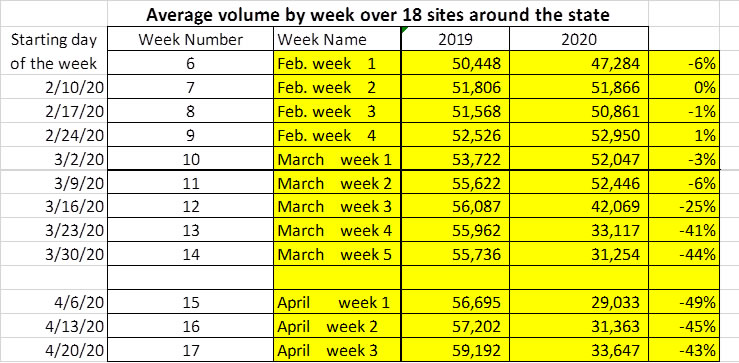
By Lindsay Street, Statehouse correspondent | Nearly one-in-three workers in South Carolina are now working from home. It’s a dramatic change that will have big consequences: As the state begins allowing in-person businesses to operate in the coming weeks, public and private employees may continue with work-from-home options, either to maintain social distancing or because it lowers overhead.

“Some companies are not necessarily encouraging employees working from home to come back into the office,” said Joey Von Nessen, research economist at the Darla Moore School of Business. “If they have been able to successfully transition to working from home and maintain productivity levels then, from an employer perspective, it may make sense to continue that.”
The marked wholesale increase in working from home in the state has also affected the state’s use of roads, electricity and buildings.
Prior to state-level sheltering-at-home mandates to slow infection from coronavirus, national experts said 29 percent of workers could potentially work from home — doubling or tripling the pre-pandemic remote workforce. Now if a position allows employees to work from home, they likely have made the transition in South Carolina, according to Von Nessen said.
He said the 29 percent figure was conservative.
According to the S.C. Department of Administration, 76 percent of state employees are now working from home. State government, like private industry, is currently evaluating more remote workers in what is becoming a new normal.
“As restrictions are slowly lifted, the South Carolina Department of Administration anticipates that working from home will continue for a period of time, at a level higher than the levels that existed prior to the pandemic,” spokesman Kelly Coakley said in a statement. “Admin will continue to work closely with agencies to develop staffing plans that are tailored to the mission and operational needs of each agency, while promoting the safety of employees.”
Von Nessen said companies in professional services are most likely to have their employees successfully transition to working from home. He said much of that work is based in Columbia and the Rock Hill areas, both of which have seen “less disruption as a result of the pandemic.”
Von Nessen, known for his annual predictions for the state’s economy, said he’s hesitant to predict where work-from-home goes from here.
“There’s so much uncertainty in terms of what’s going to be happening because things can turn on a dime if we see a successful treatment that becomes available for COVID-19,” he said, adding that it will also depend on how long the pandemic keeps people at home. “The length of time we see this disruption exist will affect how we see any lasting changes that result from it.”
Here’s a look at some of the changes already experienced by a larger share of the workforce staying home.
Traffic changes
From March 23 to April 24, traffic decreased on South Carolina roads by more than 40 percent because more people worked from home, were laid off or just stopped driving as much, according to the S.C. Department of Transportation (SCDOT).
But that doesn’t mean the state’s roads got a break.

“The factors that influence wear and tear are more closely aligned to vehicle weights and stopping and starting motions on the highways,” Transportation Secretary Christy Hall told Statehouse Report this week.

“While there have been fewer passenger vehicles on S.C. roads in the recent weeks, tractor-trailers have been allowed to carry heavier loads (per the emergency orders that increased the weight limits) and we have indicators that traffic volumes in the urban areas have been a little busier than the statewide averages (roughly about 10-15 percent higher).”
Hall said the biggest impact on state roads during the lockdown was reduced traffic levels allowing “greater mobility across the state.”
“If this trend were to continue, it would mean less of a demand for very expensive highway-widening projects,” she said. SCDOT allocates about $500 million annually on projects intended to relieve congestion.
Office changes
David Feild, president of Colliers International’s Greenville and Spartanburg market, said just how an accelerated work-from-home workforce could alter real estate demand is a “speculative conversation a lot of people are having right now.”

Feild said companies may shift to smaller spaces, but still retain some office space. For example, a large company could move into a medium company’s office space. But, he said, it’s also likely that social distancing guidelines could change per-person square footage needs, so even though some workers remain at home, a company could retain the same office space to allow for more room.
He said he expects there will also be a change in office layouts.
“This is another example of a change that will impact office space,” Feild said. “It’s an evolution, no different from previous evolutions. This one just came about a little faster and more wholesale.”
Public office space has a target density of 210 square-feet per person, according to the S.C. Department of Administration. If more people worked from home in state government, then it would consolidate state-owned or commercial space to continue to meet that density, Coakley said.
This has the potential for altering state expenses. Public buildings have $103 million in deferred maintenance costs and an annual expenditure of $22 million for maintenance and operations, according to the agency.
Energy changes
State-owned Santee Cooper reported March’s energy use was down 3 percent from 2019’. While some of that is from decreased commercial demand during the work-or-home order, spokesman Mollie Gore said the mild winter and spring could also be a contributing factor. April’s numbers, due by the second week of May, will provide a better picture of impact, she said.
But overall, the utility — which serves power to nearly 2 million South Carolinians — saw an increase in residential use as manufacturing and commercial use declined, Gore said.
- In New York City, during the height of their lockdown, The New York Times found a 7 percent increase for home consumption of energy. Read more.
Gore said the utility is just beginning to look at what “return to work” looks like in the coming weeks, and that it will start to look at the altering workforce customers in the months to come. She added that this is why the utility has begun to focus on diversifying energy that can be added incrementally and adjusted based on need, such as solar and natural gas investments.
- Have a comment? Send to: feedback@statehousereport.com















 We Can Do Better, South Carolina!
We Can Do Better, South Carolina!